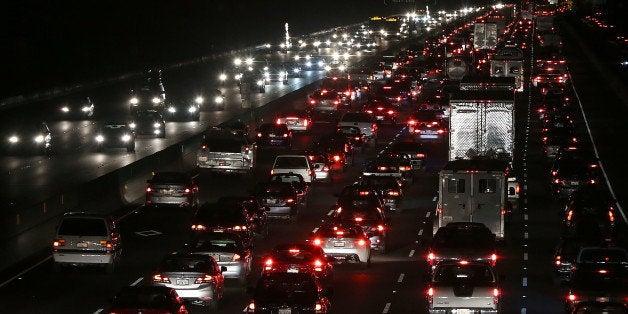
Every weekday, I take a six-mile drive through Mid-City Los Angeles to pick up my daughter from preschool. There are no fewer than 20 stoplights along the way, and my trek takes 30 minutes in each direction. But lately, that drive has been taking even longer. Ten minutes into a typical trip, I've already had to honk my horn three times to nudge traffic along.
No, I am not an aggressive driver. But I have become a frustrated one, bearing witness to a disturbing trend that seems to be growing with every passing day: Texting at stoplights.
Never mind that it's against the law in California. Or that it's dangerous: Nearly 20 percent of crashes are attributable to distracted driving, killing nine people and injuring more than 1,000 in the US every day. (If you think harm is limited to when the vehicle is in motion, you've never seen a bleary-eyed texter step on the accelerator after being jolted into action by the cacophony of horns behind him. Admittedly, I've been that bleary-eyed person on occasion. I can tell you -- it's distracting.)
But what about the environmental cost of all that extra idling and backed-up cars? The Treasury Department estimates that traffic congestion wastes 1.9 billion gallons of gas and costs American drivers $100 billion (in lost fuel and time) a year. Add an extra five seconds to a light here and there from a texting or web-surfing driver, then multiply that times the 311,000 traffic signals in the US flashing red and green for the more than 250 million cars on the road, and you start to sense the enormity of the problem.
It's only going to get worse: The number of cars worldwide has now topped 1 billion, on its way to 1.7 billion by 2035. Urban areas are becoming more densely populated. Every wasted second will send exponentially more carbon spewing into the atmosphere -- not to mention choke us in air pollution and make our blood boil in frustration.
Hybrid car, electric car: Miles per gallon won't mean much if our streets become parking lots. So what if we could always keep traffic moving, even virtually eliminate the stoplight as a temptation for the text-happy driver?
It isn't just wishful thinking for the traffic weary. Nick Musachio, an inventor based in St. Paul, Minn., who is best known for an ultra portable home gym design used in Mars colonization research, has just been granted a US patent (No. 8,711,005) for his Always Green Traffic Control System, a new intelligent transportation technology that lets drivers avoid red lights by directing them to adjust their speed when approaching an intersection.
According to Musachio, while idling in traffic is indeed vexing, it's actually the stop-and-go cycle of traffic that has the most detrimental effect on fuel consumption and air pollution. (See this modeling from Queensland University researchers.) By allowing for a near-continuous flow of traffic, Always Green can markedly reduce emissions, as well as boost MPG by a conservative calculation of 30 percent.
David Levinson, a professor in the Department of Civil Engineering at the University of Minnesota, has already written an eloquently technical how-it-works overview of Musachio's system on his Transportationist blog, so I'll let him do the explaining:
Imagine you have an isolated signalized intersection, operating near but below capacity. If vehicles were able to travel at the correct speed when approaching the intersection for a significant distance, they should be able to travel through the intersection without hitting a red light or being delayed by standing queues. If at 45 MPH they would hit a red light, but at 35 MPH would get a green, they should be informed to reduce speed to 35 MPH...
How would drivers know which speed to travel? An upstream Variable Message Sign with Dynamic Speed Limits (tied into the traffic signal controller cabinet, or with the pre-programmed traffic signal timings) would tell them the best speed to avoid stopping.
While it might be difficult to envision a harried commuter voluntarily slowing down, the beauty of the system is that there doesn't have to be 100 percent compliance. The first vehicles following the advised speed essentially become pacer cars, with the cars behind falling in line. Musachio calls these "platoons," and you can see them moving smoothly along in the simulation, below:
The modeling, which was done by the Minnesota Traffic Observatory, demonstrated a 95 percent reduction in traffic wait times -- another compelling argument for lead-footed drivers that faster doesn't equal better.
Audi has just released a similar in-car system that directs drivers to avoid red lights via a signal in its dashboard, but it could have limited impact compared with a system that relies on more visible public signage. "What does it do if you have 20 cars and only one guy has the system?" asks Musachio. "If you don't inform everybody, you may as well not inform anybody."
Electronic signage may also be the most "democratic" option, he adds, given that the average car in the US is over 11 years old and may not even be able to be updated with an Audi-esque system, were it made more widely available.
Which leads to one interesting implication for the Always Green system, if adopted -- one that I have personal interest in, given that I drive a 10-year-old car and am always angling to drive my husband's more fuel-efficient hybrid: In a system where traffic is always flowing, hybrid cars no longer have the advantage over conventional cars, since they generate their power from starting and stopping (which is why they get higher mileage in the city and lower mileage on the highway).
But the technology does make electric cars more viable, which could clear the way for a truly robust electric car market (plug-ins comprised just over half a percent of the market last year), further reducing global greenhouse gases and having a marked impact on air pollution and our public health.
Air pollution is now our greatest environmental health threat, responsible for 7 million deaths worldwide each year. I say Musachio's technology is worth a shot.
Got a great idea for my next Innovation Earth column? Send tips, thoughts and suggestions to jennifer@jennifergrayson.com.
